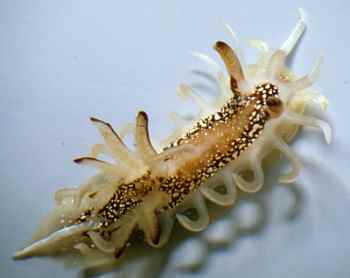
Okenia barnardi
Baba, 1937
Order: NUDIBRANCHIA
Suborder: DORIDINA
Superfamily: ANADORIDOIDEA
Family: Goniodorididae
DISTRIBUTION
Originally described from Japan is known from only a few records from Japan and Hong Kong.
PHOTO
Hong Kong. Site 11.87, South Ninepin (SE), 19 m. Depth range: 4-19 m. AM C149770, 4 specimens, 16 March 1986. Photo: B.W. Darvell
The body is elongately ovate, relatively high and lacks a distinct mantle edge although its position is clearly marked by the 8 or 9 large lateral papillae along each side, all of similar size. Usually the 2 most posterior papillae on each side are arranged one above the other on a common base. There is also a single mediodorsal papilla, similar in shape and length to the lateral papilla, just in front of the gills. The gills are long and simple and arranged in 3 clusters. The rhinophores are long, similar in length to the dorsal papillae. It grows to 10 mm long.
The body is translucent white. The dorsum is dark brown, with opaque white spots of irregular size and shape, except for area in the midline between the gills and the rhinophores. which is a much lighter translucent brown, and has fewer and smaller opaque white spots. The posterodorsal part of the foot has a brownish tinge and there is a broad opaque white median line which runs to the posterior tip of the foot. The rest of the foot is translucent white with scattered opaque white spots. The mantle papillae are translucent whitish and the upper half of the anterior 4 are opaque white. In the other papillae the white cap is replaced by an opaque white line which runs up the outer edge. The posterior side of the rhinophore stalk is dark brown with white spots, and the rest of the rhinophore is translucent brown except for the tip which is also dark brown. The gills are translucent brown with a dark brown line along the outer edge.
Okenia barnardi is known from very few records from Japan and China. It has similarities in external shape and anatomy to Okenia virginiae and O. mellita. Externally this species can be characterized by its colour pattern, the relatively numerous recurved lateral papillae, and the single medio-dorsal papilla. See message #12642 for photos of radula. We have little information on the natural history of this species, but Bernard Picton's observations [message #5962] suggests it feeds on an encrusting bryozoan.
-
Rudman, W.B. & Darvell, B.W. (1990) Opisthobranch molluscs of Hong Kong. Part 1. Goniodorididae, Onchidorididae, Triophidae, Gymnodorididae, Chromodorididae, (Nudibranchia). Asian Marine Biology, 7: 31-79
-
Rudman, W.B. (2004) Further species of the opisthobranch genus Okenia (Nudibranchia: Goniodorididae) from the Indo-West Pacific. Zootaxa, 695: 1-70.
Rudman, W.B., 2004 (December 21) Okenia barnardi Baba, 1937. [In] Sea Slug Forum. Australian Museum, Sydney. Available from http://www.seaslugforum.net/find/okenbarn
Related messages
Okenia cf. barnardi from Ratnagiri, India.
January 20, 2010
From: Vishal Bhave
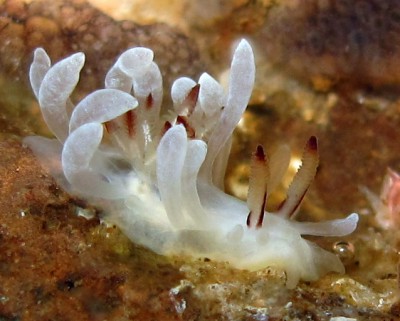
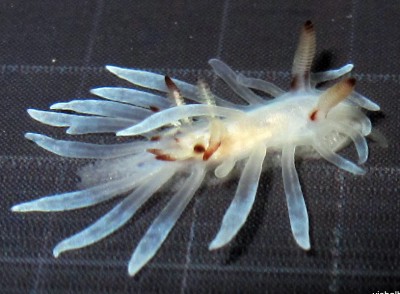
Dear Bill
Single specimen seen and collected. I am bit doubtful on its identity,
I also contacted R.C. Willan through mail and he responded
"The white Okenia is possibly O. barnardi, but the colours on the mantle, rhinophores and gills are different (very pale semi-transparent white instead of brown), the papilla in front of the gills appears to be significantly larger, and the tips of the lateral papillae seem more inflated. So, like you have done, I would call it Okenia cf. barnardi. That is until you find another specimen and then can assess if it shows features that intergrade with true O. barnardi."
Locality: Mandavi, Ratnagiri, 48 centimetres, Maharashtra, India, Arabian sea, 29 December 2009, Intertidal, rockpool. Length: 12 mm. Photographer: Vishal Bhave.
Vishal Bhave
vishalbhave@gmail.com
Bhave, V.J., 2010 (Jan 20) Okenia cf. barnardi from Ratnagiri, India.. [Message in] Sea Slug Forum. Australian Museum, Sydney. Available from http://www.seaslugforum.net/find/23048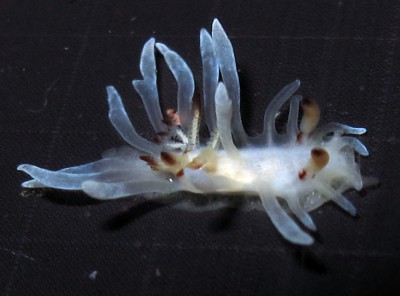
Dear Vishal,
I would agree with Richard's tentative identification. Of course if we are thinking of this animal as having lost the brown pigmentation usually found in O. barnardi then we have to think of similar looking species such as Okenia virginiae and Okenia kendi which would also look quite white without their brown pigmentation.
As Richard suggests we will need to wait until a few more specimens turn up - hopefully with a little more colour to give us some clues
Best wishes,
Bill Rudman
Okenia barnardi laying eggs in Korea
February 4, 2005
From: Dong Bum Koh
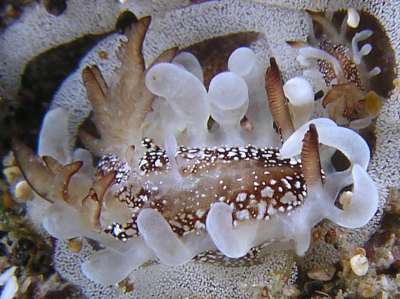
Dear Bill,
Here is a photo of Okenia barnardi laying eggs. Usually we can see two animals like in the photo, with one being big and the other small, during the breeding season. This photo was taken at night diving.
Locality: Jeju island. Hwa soon beach. South Korea. Depth: 4 m. Length: 10 mm. 16 Nov. 2004. Sandy bottom with Rock Wall. Photographer: Dong Jin Jwa
Best regards,
Dong Bum Koh
drkoh@seasee.co.kr
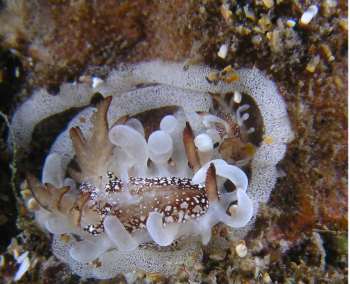
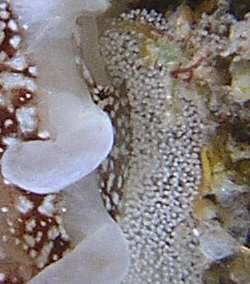
Dear Koh,
This photo of Okenia barnardi is very welcome. It is particularly interesting to hear of the large and small specimens pairing together in this way.
Best wishes,
Bill Rudman
Radula of Okenia barnardi
December 21, 2004
From: Bill Rudman
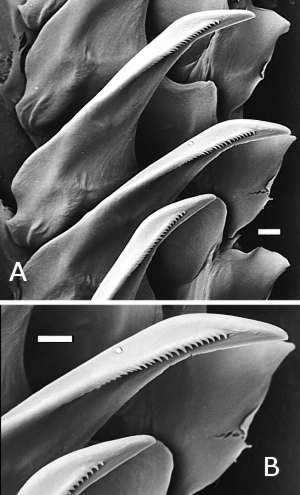
Here are some scanning electron microscope photos of the radula of Okenia barnardi, which has recently been reviewed (Rudman, 2004).
The radular formula (20 x 1.1.0.1.1) and shape of the teeth is fairly typical of the Goniodorididae. The innermost tooth has a broad base which extends up into a rounded and distinct dorso-lateral corner, and there is a typical elongate pointed cusp with approximately 20 small, pointed denticles along the cutting edge. The much smaller outer teeth have a broad triangular shape with a slightly recurved rounded tip.
PHOTOS: SEM photos of radula. A, Section of right side of radular
ribbon. B, close-up, showing fine denticles near tip of inner teeth. Hong Kong, South Ninepin (SE), 19m, 16 March 1986, 19m, AM C149770. Scale bar = 10 µm. Photo: G. Avern.
-
Rudman, W.B. (2004) Further species of the opisthobranch genus Okenia (Nudibranchia: Goniodorididae) from the Indo-West Pacific. Zootaxa, 695: 1-70.
Bill Rudman
Rudman, W.B., 2004 (Dec 21) Radula of Okenia barnardi. [Message in] Sea Slug Forum. Australian Museum, Sydney. Available from http://www.seaslugforum.net/find/12642Okenia barnardi from Japan
November 25, 2003
From: Yukari Sato
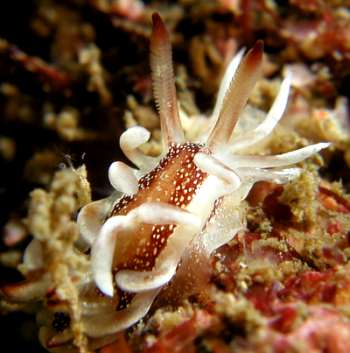
Hello Dr.Rudman,
I have found this animal at Zushi, Japan.
I guess this is Okenia barnardi. It was very glad to find this species for the first time.
Date: 2 Nov 2003
Depth: 15m
Length: 12mm.
Location: Zushi (near Hayama), Sagami Bay, Japan
Best regards,
Yukari Sato
yukarisss@hotmail.com
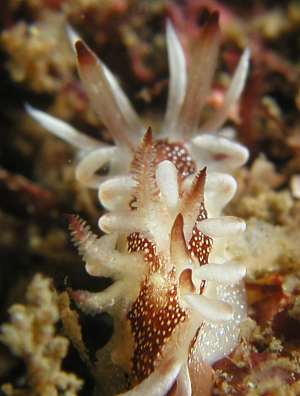
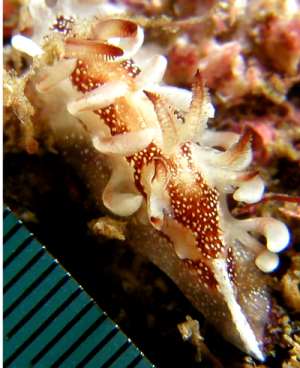
Dear Yukari,
Thanks for these photos. This appears to be quite an uncommon species and since it was first described by Baba from Japan [Osaka Bay, Toyama Bay], it is good to get some photos of animals from Japan to join those on the Forum from Hong Kong
Best wishes
Bill Rudman
Okenia barnardi from Hong Kong
January 12, 2002
From: Bill Rudman & Brian Darvell

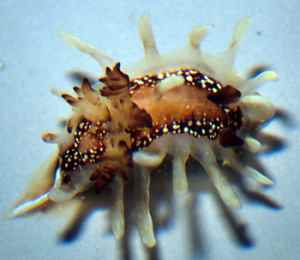
To accompany Bernard Picton's photos, here is some information and photos on Okenia barnardi from Brian Darvell's Hong Kong collections.
The mantle is pale brown darkening to a deep brown band around the edge with scattered white spots. There is a single row of long colourless papillae around the mantle edge, tipped with white, and a single papilla in the centre of the back. The gills and elongate rhinophore clubs are a watery brown with dark brown edging. The foot is translucent clear. It grows to 10 mm long.
PHOTO: UPPER: AM C149770, 4 specimens, 16 March 1986, Site 11.87, South Ninepin (SE), 19 m. Depth range: 4-19 m. LOWER: AM C139081, 2 specimens, 8 April 1983, Site 5.51, Heung Lo Po, Tolo Channel (Gruff Head), 5-10 m. Photos: Brian Darvell.
Hong Kong Collection Records:
AM C139081, 2 specimens, 8 April 1983, Site 5.51, Heung Lo Po, Tolo Channel (Gruff Head), 5-10 m. AM C139082, 2 specimens, 10 April 1983, Site 4.57, Bate Head, Mirs Bay, 5-10 m. AM C139083, 14 April 1983, Site 2.66, Round Is. (W), Mirs Bay, 3-6 m. AM C139084, 2 specimens, 19 April 1983, Site 4.8, Breaker Reef, Mirs Bay, 5-16 m. AM C149770, 4 specimens, 16 March 1986, Site 11.87, South Ninepin (SE), 19 m. Depth range: 4-19 m.
Reference:
• Rudman, W.B. & Darvell, B.W. (1990) Opisthobranch molluscs of Hong Kong. Part 1. Goniodorididae, Onchidorididae, Triophidae, Gymnodorididae, Chromodorididae, (Nudibranchia). Asian Marine Biology, 7: 31-79
Best wishes,
Bill Rudman & Brian Darvell
Okenia barnardi from Hong Kong
January 12, 2002
From: Bernard Picton
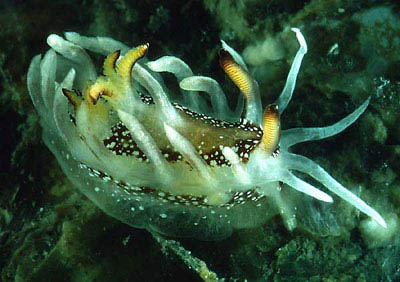
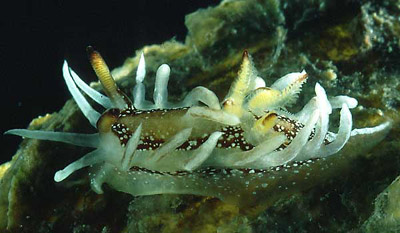
Hi Bill,
These pictures of Okenia barnardi were taken in Hong Kong in April 1983. In a separate message I am sending an in situ picture showing two animals on what I presume to be their food - an encrusting bryozoan.
Bernard
bernard.picton.um@nics.gov.uk
Picton, B., 2002 (Jan 12) Okenia barnardi from Hong Kong. [Message in] Sea Slug Forum. Australian Museum, Sydney. Available from http://www.seaslugforum.net/find/5961Thanks Bernard,
Bill Rudman
Food of Okenia barnardi in Hong Kong
January 12, 2002
From: Bernard Picton
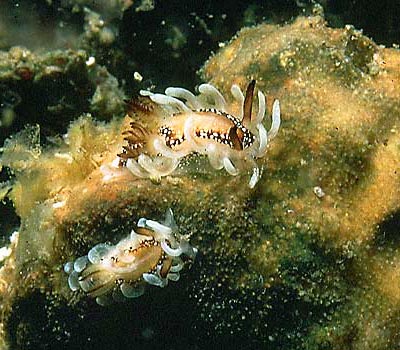
Hi Bill,
Here is another photo of Okenia barnardi taken in Hong Kong in April 1983. It is an in situ picture showing two animals on what I presume to be their food - an encrusting bryozoan.
Bernard
bernard.picton.um@nics.gov.uk
Picton, B. E., 2002 (Jan 12) Food of Okenia barnardi in Hong Kong. [Message in] Sea Slug Forum. Australian Museum, Sydney. Available from http://www.seaslugforum.net/find/5962Thanks Bernard,
Bill Rudman
